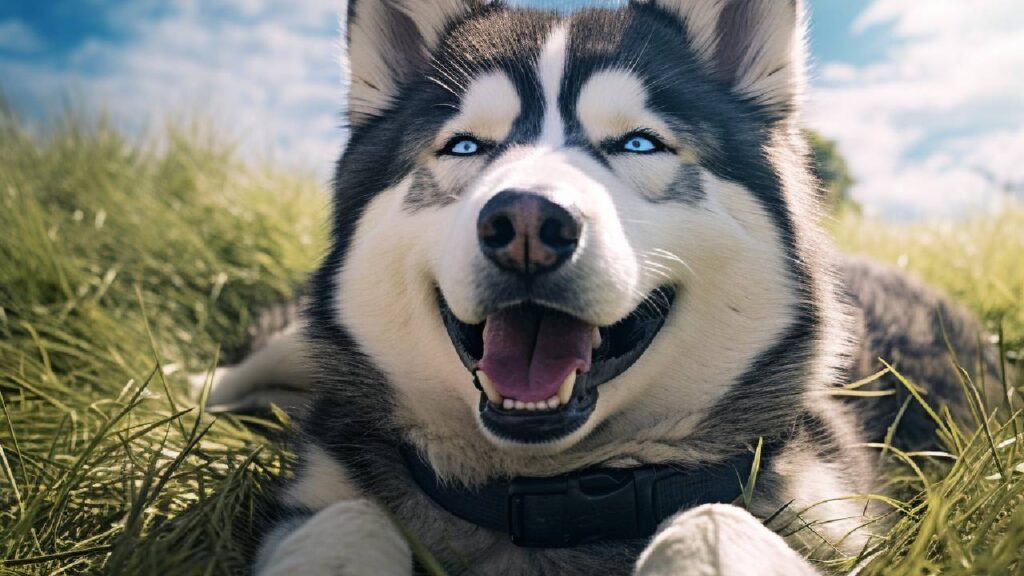Dogs, with their diverse and fascinating traits, never amaze us. Among their many mysteries, the enigmatic presence of blue tongues in certain breeds has captured the curiosity of dog enthusiasts worldwide.
Dogs with Blue Tongue
This article will dive deep into the captivating world of dogs with blue tongues. We’ll explore the reasons behind this unique feature, delving into the factors that give rise to it, and spotlight the specific breeds known for sporting these distinctive azure tongues.
Why Do Some Dogs Have Blue Tongues?
The distinctive blue tongues in certain dogs are primarily attributed to the presence of melanin, a pigment responsible for skin, hair, and eye coloration in animals, and the color of a dog’s tongue.
Melanin has two forms: eumelanin, responsible for black and brown pigments, and pheomelanin, which produces red and yellow colors. In dogs with blue tongues, there’s an elevated concentration of eumelanin in their tongue tissues.
This increase in eumelanin results from genetic factors, specifically a dominant gene that causes the tongue to have this unique hue. However, it’s important to note that melanin alone isn’t the sole factor contributing to blue tongues in dogs.
Other factors, including genetics, can influence the amount and distribution of melanin in the tongue tissue, further contributing to the variation in tongue color.
What Causes Dogs to Develop Blue Tongues?
- Genetic Factors:
The primary cause of blue tongues in dogs is a dominant gene that influences melanin distribution in the tongue. It’s this genetic trait that leads to the unique hue of their tongues.
- Variation in Tongue Color:
While melanin content is crucial, other genetic factors can influence the amount and distribution of melanin, resulting in variations in tongue color even among dogs of the same breed.
- Breed-Specific Expression:
Some breeds, like the Chow Chow and Chinese Shar-Pei, are more likely to exhibit pronounced blue tongues due to the prevalence of these genetic factors.
- Natural Diversity:
The occurrence of blue tongues is a part of the natural diversity among dog breeds, adding to their individuality and making them even more intriguing.

What Dog Breeds Have a Blue Tongue?
Not all dog breeds have blue tongues, but several breeds are known for this distinctive feature. The most famous of these you can see here:
Chow Chow
The Chow Chow is the most famous breed associated with blue tongues. This distinctive, lion-like dog boasts a solid and deep blue-black tongue. This unique feature further accentuates their ancient lineage and regal appearance.
Eurasier
The Eurasier, a breed known for its friendly and gentle nature, can also have blue-black tongues. Eurasiers are rare, but their striking blue tongues add to their overall charm.
Thai Ridgeback
The Thai Ridgeback is a unique breed from Thailand, known for its loyalty and distinctive appearance. Many Thai Ridgebacks have blue tongues, making them stand out in the world of canines.
Chinese Shar-Pei
The Chinese Shar-Pei is famous for its wrinkled skin, and some members of this breed have dark, bluish-black tongues. Their tongues, combined with their distinctive appearance, contribute to the Shar-Pei’s appeal.
Tibetan Mastiff
The majestic Tibetan Mastiff, renowned for its strength and guarding abilities, can also exhibit the striking feature of a blue-black tongue. This adds to the allure of this ancient and imposing breed.

Can Blue Tongues in Dogs Be a Medical Concern?
In most cases, having a blue tongue indicates no underlying health issues. However, being vigilant about your dog’s overall oral health is essential.
If you notice any unusual changes in your tongue’s color or if other concerning symptoms accompany it, it’s advisable to consult with a veterinarian to rule out any potential medical concerns.
The enigma of dogs with blue tongues is a fascinating aspect of canine diversity. While a blue tongue or spots may surprise some, it’s essential to understand that it’s a natural variation and doesn’t affect a dog’s well-being.
So, the next time you encounter a dog with a striking blue tongue, you’ll know it’s another charming aspect of their incredible diversity.

FAQs
Can a dog’s tongue color change over time?
No, a dog’s tongue color remains constant throughout its life. If a dog is born with a blue tongue, it will have a blue tongue for its entire life.
Can mixed-breed dogs have blue tongues?
Yes, mixed-breed dogs can have blue tongues if they inherit the relevant genes from their parent breeds.
Are there any specific care considerations for dogs with blue tongues?
Dogs with blue tongues require the same care and attention as any other breed. Regular veterinary check-ups and proper oral hygiene are essential for all dogs.
Do all Chow Chows and Chinese Shar-Peis have blue tongues?
While it’s a common trait in these breeds, not every individual within them will have a blue tongue. The presence of a blue tongue can vary even among dogs of the same breed.
Can blue tongues in dogs affect their behavior or temperament?
No, a dog’s tongue color, whether pink or blue, has no impact on their behavior or temperament. It’s purely a physical characteristic and does not influence their personality or disposition.






Wow, blue tongues on dogs? I had no idea! Anyone else have a dog with a unique tongue color? 🐕👅💙
never see it